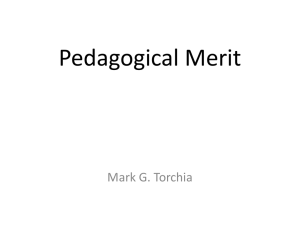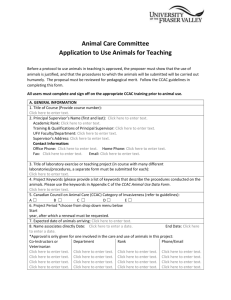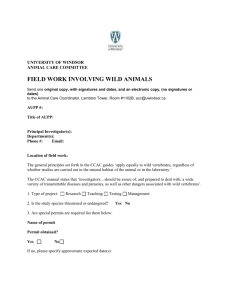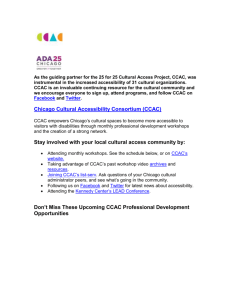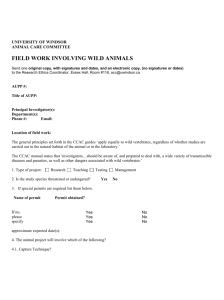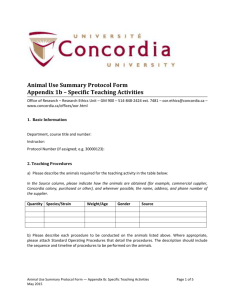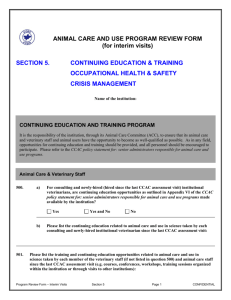Field Studies - Vancouver Island University
advertisement
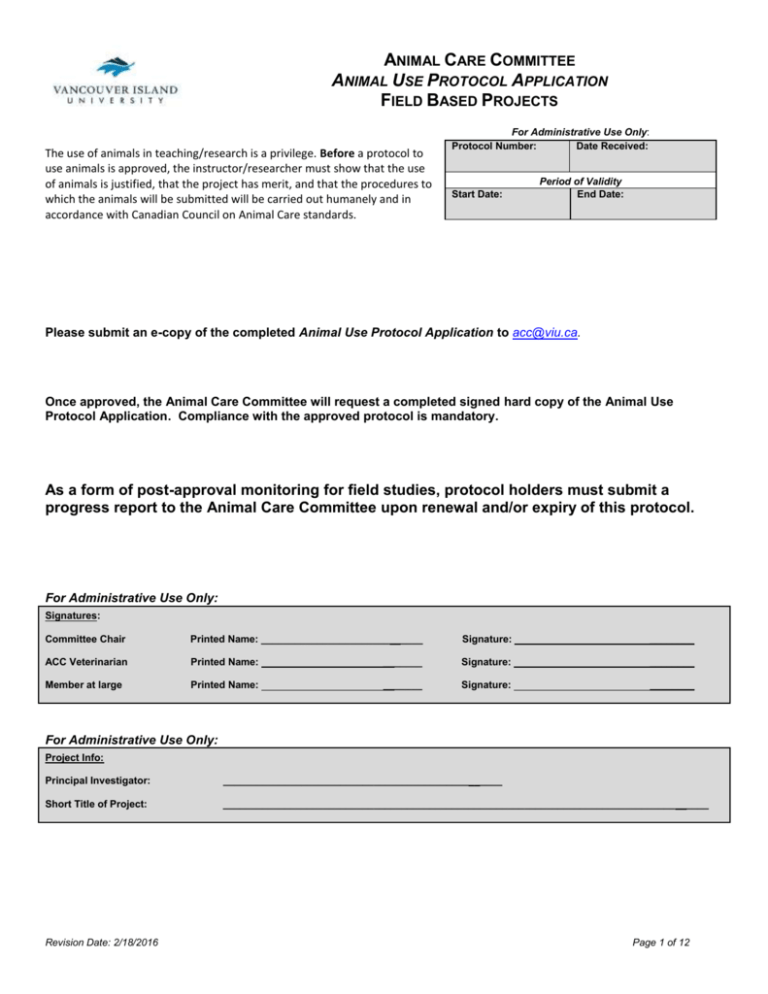
ANIMAL CARE COMMITTEE ANIMAL USE PROTOCOL APPLICATION FIELD BASED PROJECTS The use of animals in teaching/research is a privilege. Before a protocol to use animals is approved, the instructor/researcher must show that the use of animals is justified, that the project has merit, and that the procedures to which the animals will be submitted will be carried out humanely and in accordance with Canadian Council on Animal Care standards. For Administrative Use Only: Protocol Number: Date Received: Start Date: Period of Validity End Date: Please submit an e-copy of the completed Animal Use Protocol Application to acc@viu.ca. Once approved, the Animal Care Committee will request a completed signed hard copy of the Animal Use Protocol Application. Compliance with the approved protocol is mandatory. As a form of post-approval monitoring for field studies, protocol holders must submit a progress report to the Animal Care Committee upon renewal and/or expiry of this protocol. For Administrative Use Only: Signatures: Committee Chair Printed Name: _____________________________ Signature: ________ ACC Veterinarian Printed Name: _______ Signature: ________ Member at large Printed Name: _______ Signature: ________ For Administrative Use Only: Project Info: Principal Investigator: __________________________________________________ Short Title of Project: _______________________________________________________________________________________ Revision Date: 2/18/2016 Page 1 of 12 Please check one: First Submission Revision (include Application for Amendment form) Resubmission (every 3 years) I. General Information Purpose of Protocol: Teaching (Also complete Appendix A Description of Educational Value) Research (Also complete Appendix B Summary of Scientific Merit) Current Protocol Number (not required for First Submission): Course Number(s) and/or Descriptive Project Title: Anticipated Start and End Dates for Protocol Activities: Principal Instructor/Investigator: Dr. Academic Position: Faculty Mr. Ms. Technician Other (please specify) Vancouver Island University Department: Location of Study: Please provide location of study, being as specific as possible. Please include UTM co-ordinates or lat/long if known: Office Address: Telephone Number (Office): ( ) ext. E-Mail Address: Declaration: I, the undersigned, assure that all animals used in this proposal will be cared for in accordance with the guidelines of the Canadian Council on Animal Care and Vancouver Island University. Declaration: I, the undersigned, am aware of the human and facilities resources required for undertaking this project. Dean, Faculty of Vancouver Island University Principal Instructor / Investigator: Signature Name: Signature Name: Date: (yyyy-mm-dd) Date: (yyyy-mm-dd) II. Lay Summary of Project: Summary of protocol and justification for animal use, including educational or research value and procedures to be used. (Use LAY language, suitable for a press release and public presentation. < 300 Words) III. Keyword Description of Protocol Revision Date: 2/18/2016 Page 2 of 12 IV. Personnel and Qualifications a. Staff and Training NAME (last, first) POSITION / DEPT. CCAC Core Training Completed? (all 4 modules) Yes No Yes No Yes No Yes No Yes No Yes No Other Training / Qualifications (Specify) (including other CCAC modules) SIGNATURE (Indicates individual has read this AUP – scanned/emailed signature acceptable for off campus personnel) For information on CCAC Training through VIU’s online system please contact acc@viu.ca or visit viu.ca/animalcare. b. Emergency Personnel List two people who will be available to assist in the field in an emergency situation (e.g. animals in traps and investigator injured, etc.) NAME (last, first) c. POSITION / DEPT. Work Phone ( ) ext. ( ) ext. Home Phone Additional Assistance Personnel List person(s) who may be required to ensure that the project will be carried out in a competent and humane manner, (i.e., Veterinarian Consultant or other specialist below.) NAME (last, first) POSITION / QUALIFICATIONS. Work Phone Home Phone Signature d. State conditions under which these personnel will be contacted. e. For teaching protocols what will the ratio of instructors to students be in this project? Revision Date: 2/18/2016 Page 3 of 12 V. Protocol Categories a. Purpose of Animal Use (PAU) Choose the item (1-5) below that best describes the purpose of animal use: 1. Studies of a fundamental nature in sciences relating to essential structure or function (e.g., biology, ecology, psychology, biochemistry, pharmacology, physiology etc.) 2. Studies for medical purposes, including veterinary medicine, that relate to human or animal disease or disorders. 3. Studies for regulatory testing of products, for the protection of humans, animals, or the environment. 4. Studies for the development of products or appliances for human or veterinary medicine. 5. Education and training of individuals in post-secondary institutions or facilities. b. CCAC Category of Invasiveness CCAC Category of Invasiveness: : http://www.ccac.ca/en_/standards/policies/policy-categories_of_invasiveness A Procedures involving invertebrates (excluding cephalopods) or live isolates. B Procedures which cause little or no discomfort or stress. C Procedures which cause minor stress or pain of short duration. D Procedures which cause moderate to severe distress or discomfort. E Procedures which cause severe pain near, at, or above the pain tolerance threshold of unanaesthetized conscious animals. VI. Animal Information a. Scientific Name Common Name Number Per Year Indicate Target Species (T) or Non-target (N) b. Justify the use of live animals. Please include possible replacements considered and why these are not being used. List the sources and databases searched for alternatives to the use of animals. (Suggested reference: CCAC Resource Centre web page http://www.ccac.ca/en_/resource-centre) c. Justify the choice of species and strain. Revision Date: 2/18/2016 Page 4 of 12 d. Justification of Numbers Use statistical or pedagogical arguments to justify the number of animals used. e. Non-target species If applicable please indicate what steps will be taken to minimize the capture of non-target species and what will be done with any non-target species caught. f. Regulatory Requirements. Copies of all authorizations are to be included with approved and filed protocol. Verification of permits listed as pending must be forwarded to the ACC prior to the start of the project. Collection Permit(s)# Transport Permit # Biohazards (specify) Prescriptions (specify) Controlled Substance (specify) Other (specify) VII. Describe Procedures Involving Animals a. Please check all procedures that apply to this project. Capture Methods: minnow trap mist netting other fish trap long-worth trap electrofishing mammal cage trap seine netting hand capture gill netting Other: dip netting Marking Methods: fin clip internal radio transmitter ear/fin tag external ratio transmitter leg-band elastomer paints or dyes Other: PIT tags Revision Date: 2/18/2016 Page 5 of 12 b. Describe, in detail, all procedures. Use language that can be understood by a trained biologist. Refer to approved SOPs wherever possible. Be sure to include any variations to the relevant SOPs. If experimental drugs will be used, describe the known effects. Details regarding how the animals will be monitored are addressed in Section X of this form. For resubmission, highlight major scientific findings and describe procedural improvements. **Box will expand to accommodate text that is inserted ** Procedure Person Performing Qualified in the Procedure Y/N 1. Yes No 2. Yes No 3. Yes No 4. Yes No 5. Yes No If no, who is responsible for procedure training? c. Euthanasia: In the event an animal has to be euthanized, will CCAC Recommended Procedures be used? Yes No In either case, please specify method of euthanasia if not already covered in Section VII.a. Refer to SOPs if appropriate. Please note: Physical means without anaesthetics will need to be justified and competence demonstrated in the presence of an ACC representative. VIII. Drugs and Chemicals Are any drugs and/or chemicals being used in this project, including drugs and chemicals used for Euthanasia? Yes No If ‘yes,’ complete Sections A, B, and/or C, following below: A. Euthanasia: In the event drugs need to be used to euthanize an animal, provide the details below for each species. For fish, refer to page 64 in the guidelines at http://www.ccac.ca/Documents/Standards/Guidelines/Fish.pdf. Drug Dosage Route Person Responsible B. Anaesthetic agents (not including euthanasia agents): Give details of the anaesthetic regime to be used. Include dosages, maximum volume allowable per animal per administration site (*See Guideline), and routes of administration for each species. Name the person(s) who will administer and monitor anaesthetic. Drug Revision Date: 2/18/2016 Dosage Route Person Responsible Page 6 of 12 C. Experimental Drugs and Treatments (incl. drugs used in protocol, e.g., analgesics, tranquilizers, antibiotics. etc.) List all experimental, prophylactic and therapeutic drugs, chemicals and biologicals that may be used. Give dosages, maximum volume allowable per animal per administration site routes of administration, and duration. Name the person(s) who will administer the agent(s). If the experimental drug is proprietary, provide class of drug. (*See CCAC Guidelines for fish, pg. 57) http://www.ccac.ca/Documents/Standards/Guidelines/Fish.pdf) For other animals, see Guidelines on Antibody Production – Appendix B http://www.ccac.ca/Documents/Standards/Guidelines/Antibody_production.pdf Analgesics Drug Dosage / Frequency / Duration Route Person Responsible Tranquilizers Drug Dosage / Frequency / Duration Route Person Responsible Antibiotics Drug Dosage / Frequency / Duration Route Person Responsible Other Drug Dosage / Frequency / Duration Route Person Responsible What are the expected and possible side effects of these drugs? Revision Date: 2/18/2016 Page 7 of 12 IX. Dangerous Materials and Procedures A. Hazardous Agents. Will any hazardous agents be used in this project? Yes No If 'yes', indicate the agent(s) below Chemicals Biohazards Flammables Liquids or Gases Compressed Gas Flammable and Combustible Material Oxidizing Material Poisonous and Infectious Materials Corrosive material Dangerously reactive material Bacteria Viruses Parasites Fungi Prions Toxins DNA recombinants Genetically modified organisms Viral vectors Synthetic DNA and synthetic biology Cell lines Blood and body fluids Radiation Radioisotopes x-rays B. Occupational Health and Safety Risks. Please check the occupational Health and Safety risks associated with this project. Physical Risks Cuts (e.g. use of needles, sharps, etc.) Bites and Scratches Lifting and handling loads manually Highly repetitive motions Slipping and Tripping Hazards Moving parts of Machinery Working at Height Pressurized systems Vehicles Fire Electricity Excess noise (e.g. fans, compressor) Extreme Temperatures Vibration Dust Biological Risks not listed above Sewage Effluent Exposure to zoonotic disease Other Risks Working alone Working in remote/isolated area Other (please specify): For any of the above that could affect animal welfare (for example cutting yourself during an animal surgery, being bit by animal during handling), please indicate how risks will be minimized. If has been covered in Section VII. a. Procedures, please indicate. Revision Date: 2/18/2016 Page 8 of 12 X. Humane Monitoring, Intervention and Endpoints: See pages 59 – 62 for Fish http://www.ccac.ca/Documents/Standards/Guidelines/Fish.pdf and http://www2.viu.ca/animalcare/GuidelinesforChoosingAppropriateInterventionandEndpoints.asp Frequency of monitoring animals and/or traps: Who is responsible for monitoring animals and/or traps? Name: Contact number: Humane Intervention and Endpoints: In the event that your project leads to a life-threatening condition, please describe the intervention and endpoints for the animal that will lead to treatment and/or humane euthanasia respectively. The endpoints should incorporate time and/or condition and be applicable to individual animals (e.g., weight loss, loss of equilibrium, etc.). (See CCAC Guidelines for Endpoints - http://www.ccac.ca/Documents/Standards/Guidelines/Appropriate_endpoint.pdf) Describe how the following aspects of the animal may change in the course of this experiment/teaching exercise and which particular changes will signal action required to reduce or relieve animal distress. Animal activity Possible changes or complications Signal for intervention Intervention Feeding activity Physical appearance Clinical signs Unprovoked behaviour Provoked behaviour Revision Date: 2/18/2016 Page 9 of 12 Who is responsible for determining an intervention point has been reached? Name: Contact number: Who is responsible for determining if humane euthanasia is indicated, based on the presence of a specific endpoint(s)? Name: Contact number: Explain the chain of communication for the results of monitoring so that the process from observation to intervention is clear. For experiments in which animals are evaluated beyond the initial experimentation procedure (i.e., after surgery), including experiments in which no anaesthetic is administered: Include the expected numbers and the expected cause of morbidity and mortality. This does not include mortality due to euthanasia. Expected Morbidity: Expected Cause: Expected Mortality: Expected Cause: XI. Fate of Animals What will be the ultimate fate of the animals? What will happen to animals not euthanized and how will euthanized animals be disposed of? What steps, if any, will be taken to ensure any impacts of stress associated with handling are minimized postrelease (if applicable and not covered in Section VII)? Revision Date: 2/18/2016 Page 10 of 12 APPENDIX A Description of Educational Value (Must be completed for teaching projects) Please describe the educational merit of this project, relating it to the course and program’s learning objectives. Databases: List the sources and databases searched for alternatives to the use of animals. Revision Date: 2/18/2016 Page 11 of 12 APPENDIX B Summary of Scientific Merit (Must be completed for research projects) **Please read Peer Review Guidelines, http://www.viu.ca/animalcare/PeerReviewofScientificMeritofResearch.asp before filling out Appendix B** Potential Benefit of the Research Specific scientific objectives and potential value. (This can be brief if exemption “a” of the peer review applies) Peer Review: Has this research proposal been previously peer reviewed? Yes No If “yes,” Name(s): Internally Externally Funding Information Source of Funds Funds Administered by: Vancouver Island University Cost Centre Number: Funding Agency: (Required for invoicing of project costs) Status: Internal External Awarded Pending Other Provide Details Secondary Funding Agency:: Internal External Status Awarded Pending Funding Start Date: (yyyy-mm-dd) Funding Finish Date: (yyyy-mm-dd) Revision Date: 2/18/2016 Page 12 of 12
